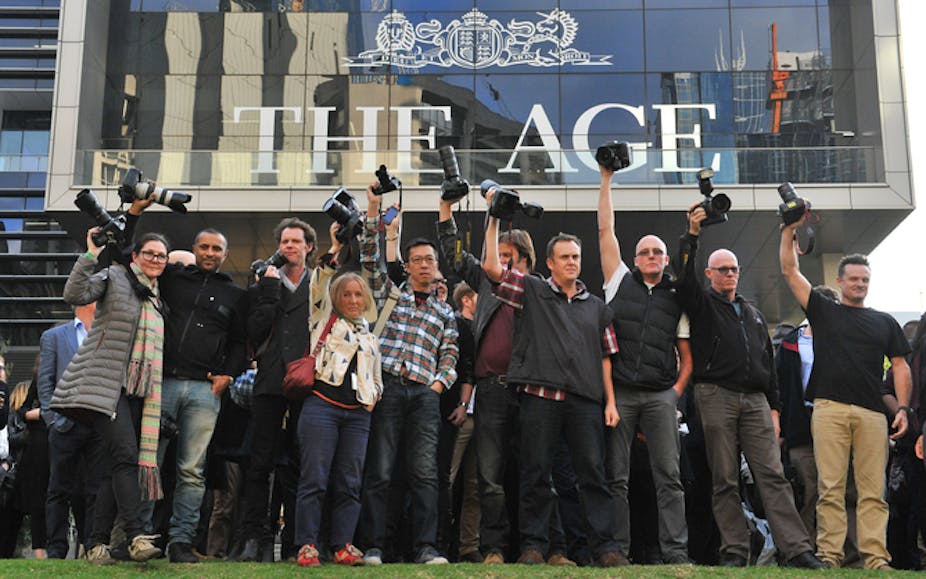You know the adage: a picture is worth a thousand words. News photographs can capture a story’s emotion whether it is sport, politics or human tragedy. Think of the 1983 America’s Cup win. Prime Minister Bob Hawke wearing an ear-to-ear grin and that loud Australia jacket more like wrapping paper than clothing.
Or Nicky Winmar in 1993 lifting his St Kilda footie jumper with his middle finger pointing to his bared flesh to protest against racism. Who can forget the image of Kevin Rudd with tear-stained cheeks when he lost the prime ministership after a backroom coup in 2010; or Damien Oliver pointing his whip to the sky after winning the 2002 Melbourne Cup to salute his dead brother?

It was press photographs that captured firefighters’ blackened faces against a backdrop of a mountain town’s charred remains after Victoria’s Black Saturday in 2009. The news picture can be an indelible image that etches into a nation’s consciousness.
But in the third cost cutting announcement since 2012, Fairfax Media now sees the role of the staff photographer as dispensable after this week proposing to shed 75% of its snappers across its metropolitan mastheads. It intends to outsource photography to picture agency Getty Images.

The news triggered a 24 hour strike from editorial staff across Fairfax’s major mastheads. Journalists know photographers’ value to their own work - a remarkable photograph can elevate a story to page one - but does management? Put broadly, just how far can management go in outsourcing a newspaper – printing, distribution, sub-editing, writing and now photography – without impacting on the quality of the product?
Herein lies the conundrum for print newspaper companies in the digital era. The business model has fractured as newspapers no longer have a monopoly over advertising or producing news. Anyone with a smartphone can purport to be a citizen journalist. Anyone with a popular webpage can attract advertising. Both impact newspapers’ revenues.
Fairfax recently returned a modest underlying net profit, the first since 2010, but not without significant cost cutting including 1900 staff redundancies, reformatting Sydney and Melbourne broadsheets to tabloid and closing printing presses; and an operational restructure resulting in greater story sharing across mastheads. Now, it proposes further cuts, to photography, perhaps to save the company.
Fairfax has already increased syndication across mastheads, particularly after last year’s business reporting cutbacks, and it has centralised editorial around a Sydney-centric structure. These changes, and the plan to outsource most of its photographs to an agency instead of producing its own unique content, limit geographical and story diversity. This is a quality issue for readers in a topographically large nation with concentrated ownership of media and suggests the maxim: “one kitchen, many restaurants” might soon be true for Fairfax mastheads.
Fairfax is not the only media organisation to feel pain from the digital revolution. Australia’s largest newspaper company News Corporation Australia has also shed hundreds of jobs and centralised its editorial operations. Online outlets also find it difficult to make their journalism pay.
This week New Matilda editor Marni Cordell signalled that her online news site would close: “since January I haven’t been taking a regular wage,” she confessed in an open letter to readers. The Global Mail, a philanthropically funded news site for long-form journalism, also shut down after losing its funding this year.
A Fairfax staff tweet reported that the Age’s Editor-in-chief Andrew Holden observed, when he revealed the latest cutbacks:
It is the same fundamental change that has redefined how we consume books, music, television, videos, book holidays, accommodation and taxis; shop, communicate and even gamble. Amid these changes it could be argued that the death of the staff news photographer is inevitable.
It is not unprecedented. In February the Orlando Sentinel announced it would shed its staff photographers, and the month before, a group of Johnston Press newspapers in Britain axed their staff photographers; as did the Chicago Sun-Times last year.
A Johnston Press spokesperson said the decision was made after reviewing “the way photographic content is generated,” meaning we all can, and do, take photographs. Eyewitnesses with camera phones used Twitter to break the news of the plane crash landing in New York’s Hudson River in 2009. There is a role for citizen photographers. The argument here is not about who can break live news; newspapers lost that battle years ago.
The question is at what point does outsourcing affect newspaper quality? At their strike meeting on Wednesday, journalists complained about how downsizing staff subeditors had led to more errors in Fairfax newspapers.
When the Chicago Sun-Times replaced its photographers with reporters carrying iPhones, photographer Taylor Glascock began to compare the masthead’s daily photography with staff pictures from its competitor, Chicago Tribune. She posted screenshots from both papers’ front pages and let the images speak for themselves. The mobile phone pictures often lacked the emotion of the occasion because of poor composition or poor timing - the journalist was too busy gathering information to take timely photographs.

A good example shows a Chicago Tribune front page of a moment of celebration for the Chicago Blackhawks when they won the Stanley Cup last June. In contrast, The Sun-Times settled for a picture of the cup snapped after the celebrations, and ran the same image on two consecutive days.
Of course Getty images’ photographers are no iPhone-wielding amateurs. It is a professional outfit that sells photographs for professional use, particularly sport.

It will fill some of the void if Fairfax sheds photographers, and it will probably hire some of Fairfax’s redundant photographers. But Fairfax’s outsourcing comes at a price.
Getty’s business is snapping photographs that customers will pay for, not the practice of the still art. You only need to see the Walkley photography finalists each year to know that press photographers care more about capturing a moment in time, even at seemingly insignificant events, than the market price.

